|
SAGUARO
Ecology of the Saguaro: II NPS Scientific Monograph No. 8 |

|
CHAPTER 6:
OVERVIEW AND OUTLOOK (continued)
History in
Perspective—Ecology or Pathology?
Our investigations and the work of others leave no doubt that natural environmental factors are the underlying cause of the dramatic changes that have occurred within the saguaro populations at Saguaro National Monument since its establishment. The historical activities of man and his domestic animals have been superimposed upon the natural environmental factors that limit the natural distribution of the saguaro and, within those limits, control its germination, establishment, and survival.
Responses of an abused environment
The role of historical factors has been not to act as new and overriding controls; rather, historical factors have acted to intensify or mitigate the operation of natural regulating factors. Acting primarily in an indirect manner, the overall effect has been to decrease the number and suitability of sites for germination, establishment, and survival of young saguaros. Within Saguaro National Monument, the saguaro has not been eliminated from any of its former habitats by these activities, but rather, in some habitats, the density of large juvenile and young adult plants is below the expected level for these habitats.
There is no cause to believe that historical factors have created irreversible deterioration of any of the primary habitats of the saguaro at Saguaro National Monument. Where elimination of adverse uses has been accomplished, it has been followed by natural regeneration of the plant community, and by the establishment of large numbers of juvenile saguaros.
Termination of grazing or other actions that similarly degrade those desert habitats and environments is followed by regenerative "non-succession." It is not, however, the generally known plant succession that occurs in more mesic environments where seral stages of different sets of species replace others in a successive series of different communities. In the desert environment where moisture, rather than light, is limiting, interspecies competition takes place almost entirely within the root zone (see Cannon 1909, 1911, 1912). Thus, as in the case of the saguaro, plant species that require physical protection for their establishment and early survival follow the development of moderated microenvironments created by the canopy of trees and shrubs. These microhabitats offer protection from extremes of drought, heat, light, and cold, and in addition provide concealment and physical barriers that effectively reduce destruction by animals.
The sparsity of large juvenile and young adult saguaros in some habitats is indirectly attributable to past abuses of these environments. That is the irrevocable condition of these populations that absolutely insures that for many decades to come, as natural die-off of large, old saguaros continues, the spectacular qualities of these stands will continue to decline.
In contrast to the condition reported only a few years ago, and still presumed by many to be the situation, there are today in each of the two sections of Saguaro National Monument thousands of young saguaros less than a half-meter (20 inches) tall. These occur not only on the rocky footslopes of the Rincon and Tucson mountains—where the presence of substantial numbers of large juvenile and young adult saguaros indicates continued establishment and survival of young saguaros in these habitats—but notably in the nonrocky, flat habitats of the Cactus Forest area, and the lower bajadas of the respective east and west sections of the monument.
The unstable nature of saguaro populations within Saguaro National Monument is neither a recent nor an unnatural development. The unbalanced age-class structure evidenced by the present conspicuous lack of large juvenile and small and intermediate sizes of adult saguaros within certain of these monument stands long predates the establishment of the monument in 1933.
Both the dramatic die-off of large, old plants and the lack of younger replacements in these populations are the inevitable response to climatic events—recurring catastrophic freezes—that are a normal characteristic of the region. The particular populations in question are those which occupy marginal saguaro habitats—topographic situations where subfreezing temperatures are intensified by cold air drainage and accumulation.
Requiem for a myth
In 1838, I published . . . in an article on the intense cold of January, 1838, the following remarks—" . . . cold does not kill vegetation by a mechanical action proceeding from the congelation of the liquid as some naturalists pretend. We must recognize rather a physiological action; that the vitality of the tissue is destroyed by a certain degree of cold followed by a certain degree of heat, according to the peculiar nature of each plant. The vegetable and animal kingdom, according to this view, will act alike. In the same manner as the gangrene that sets in after the thawing of a frozen part causes the death of an animal tissue, so the change or putrefaction which follows a rapid thawing will be the principal cause of the death of the vegetable tissue."—M. A. de Candolle, "On the freezing of vegetables." 1852:445-446.
Bacterial rot is the long understood, subsequent, and ecologically important process of natural decomposition that aids the final breakdown of the soft tissues of saguaros that are killed outright or rendered physiologically dysfunctional by mechanical factors, primarily freezing and lightning (see Lowe 1964, 1966; Steenbergh 1972; Steenbergh and Lowe 1976).
Our observations, and the numerous investigations and reports of others, have established the nature of the principal causes of death of saguaros. Bacterial disease is not among these confirmed causes of mortality in natural saguaro populations, and no significant number of saguaro deaths remains to be explained by additional or unknown causes. Our ecological investigations over the last 23 years on naturally growing field populations of saguaros have resulted in no evidence that any pathogenic microorganism is, or ever has been, a significant cause of the death of saguaros—or that any death of healthy saguaros, young or old, can be attributed properly to bacterial action.
As the appointed custodian and official ecological interpreter of the best-known saguaro populations in the world, the National Park Service is heir to a difficult task. The ecologically unsupportable myth of the "bacterial necrosis disease" must be supplanted by a possibly less appealing, but ecologically realistic, interpretation: the decline of once spectacular saguaro populations at Saguaro National Monument and elsewhere in Arizona is an inevitable and continuing response of these populations to uncontrollable climatic events.
Diverse Records: Populations in
Response to Climatic Events
Diverse records on saguaro populations (and other warm-desert plant populations) and climatic events clearly tell the story of a population in trouble since the middle of the last century. The relative sparsity of young saguaros in some populations and the relationship of that condition to saguaro population fluctuations have long been a matter of record and concern.
Populations in trouble
Dense populations of saguaros near the northeast base of the Rincon Mountains east of Tucson are indicated by the previously quoted observations of Bigelow (1887). Hubbard (1899) provided observations on the condition of saguaro populations near Tucson at the end of the 19th century. Hubbard's (1899:6) 1897 observation was particularly significant:
The entire mesa at the foot of the Sta. Catalina Mountains near Sabina cañon, about 18 miles northeast of Tucson, is covered for miles and miles with immense giant cactus, in one unbroken army, as thick mullein stalks in an eastern cattle pasture. Out of these thousands of cacti I did not discover a single plant that was diseased or rotting. . . .
MacDougal (1908b) commented generally on the difficulty of finding young saguaros, but remarked that ". . . the great valley lying between the Carobabi and Quijotoa Mountains, was found to be densely inhabited by this plant, represented by individuals in all stages of development, the plantlets being so numerous in places as to form clumps."
Shreve (1910) offered the first numerical data on saguaro populations and concluded that: ". . . it is not maintaining itself in either of two situations, one of which offers the highest average water-content of any desert soil away from stream beds, and the other the temperature and other conditions which have brought about in it the densest Giant Cactus population that can be found in any habitat." In that report, he further recognized that "mechanical factors" are the principal cause of saguaro death.
Shreve (1911) subsequently established the role of freezing weather as a critical determinant of the elevational and geographic limits of saguaro distribution. Surprisingly, however, Shreve apparently did not then or later recognize the further relationship of his work on freezing to causes of saguaro death, and the observed decline of certain saguaro populations: In establishing the relationship between subfreezing temperatures and saguaro survival, Shreve (1911) had answered his own important question on the primary factor responsible for the observed fall in the rate of saguaro establishment, and had delineated the primary cause of saguaro deaths in populations near the cold-limited boundaries of its distribution (also see Thornber 1916; Lowe 1959, 1964; Steenbergh and Lowe 1976).
The saguaro population in portions of Saguaro National Monument (east) was in a long-standing state of decadence at the time of the establishment of the monument in 1933. In the photographs by Homer Shantz (Fig. 3A; also see Hastings and Turner 1965), there is an abundance of large, old saguaros, and a conspicuous sparsity of juvenile and young adult saguaros. The very characteristic that inspired Shantz (1932) to say, "Nowhere in the world is there so fine a stand of giant sahuara <(I>Carnegia gigantia) as in the University Cactus Forest." was the irrevocable condition that was to lead to the subsequent and inevitable dramatic decline of that same stand.
The first quantitative evidence on the declining condition of the east monument saguaro population was supplied by Wilder and Wilder (1939) and Wilder (1940). They not only pointed out that the saguaro was not maintaining itself in the "Lower Desert Floor" (i.e., flat habitat), but importantly concluded (Wilder and Wilder 1939) that "They are, apparently, reproducing satisfactorily in level-floored pockets just below the foothills and on the foothills (or mesas leading up to the Tanque Verde Mountains)."
Following massive die-offs of saguaros that occurred in 1939 and 1940 (Gill 1951), systematic sampling of saguaro populations at Saguaro and Organ Pipe Cactus national monuments was initiated in conjunction with "Cactus Disease Investigations" by the USDA Bureau of Plant Industry (Gill and Lightle 1942, 1946; Gill 1951; Mielke 1944; also see Steenbergh and Lowe 1976). That study included data on 12,698 saguaros in the Saguaro Monument (east) flats habitat, the largest single saguaro population sample ever taken.
The results of those investigations support the earlier observations of Wilder and Wilder (1939) and Wilder (1940) that the number of young saguaros in the east monument flats stand had long been insufficient to maintain the stand, and that the highest densities of saguaros occurred on the rocky footslopes. Further, these studies showed that at Organ Pipe Cactus National Monument there was a relatively low rate of die-off of large saguaros (7%) and, significantly, that a high proportion (33.6%) of the saguaros in that population were healthy individuals 3 ft (91 cm) or less in height (Gill and Lightle 1942). In 1941, the saguaro population at Organ Pipe Cactus National Monument exhibited, and—based on recent reexamination by the authors—continues to exhibit on the whole a relatively stable age distribution.
Investigations in 1962 (Niering et al. 1963; Niering and Whittaker 1965) on saguaro populations in the vicinity of Tucson further confirm earlier observations that saguaro establishment and survival rates in rocky habitats are higher than in the finer soil of nonrocky habitats (also see Kramer 1962; Bingham 1963). More important, these studies further support the earlier observation by Thornber (1916) that massive die-off of saguaros is associated with catastrophic freezing, and explain the relationship of freezing weather to higher survival rates in rocky habitats. From the data in those reports, it also can be seen that freeze-caused saguaro mortality decreases from east to west along a gradient of increasingly warmer winter climate.
Further data on saguaro populations in Saguaro National Monument and the relationship of saguaro size and habitat to freeze-caused mortality are reported by Steenbergh and Lowe (1976). In that report, we concluded that catastrophic freezing selectively structures saguaro populations, removing the smallest (youngest) and the largest (oldest) plants, leaving a high percentage of large juvenile and unbranched young adult saguaros with heights from 0.46 to 3.80 m (1.5-12.5 ft).
Catastrophic freezes
Daily weather observations provide a record of minimum temperatures in Tucson since 1895 (see Steenbergh and Lowe 1976, Fig. 25). Other diverse records of these climatic events and the response of saguaro populations and other cold-sensitive plant populations are scattered throughout the literature (Thornber 1912, 1916; Wiggins 1937; Turnage and Hinckley 1938; Niering et al. 1963) and are, in fact, recorded in the responsive plant populations themselves.
Saguaro populations in the Tucson vicinity are an unexamined record of catastrophic freeze occurrence that long predates the oldest written weather records (Figs. 54 and 55). The size-class structure of these and other saguaro populations is an indication of past winter climate (Fig. 55A). In many northern saguaro populations, constrictions near the base of the stem tell the story of previous catastrophic freezes. These constrictions result from freeze-caused crown-kill. In some habitats at Saguaro National Monument, such scars, present on nearly every large juvenile and adult saguaro, provide a continuous record of recurring catastrophic freezes as old as the plants themselves (Fig. 54). Based on the estimated age of larger saguaros in these habitats, recurring catastrophic freezes have been a normal part of these environments for more than 150 years.

|
| Fig. 54A. Constricted upper stem of a young, 93-cm (37-inch) saguaro at Saguaro National Monument (east) is a result of a January 1971 freeze-caused crown-kill. Four other scars (arrows) visible below the mid-point of the stem are the result of a series of freezes that occurred during the earlier years of the plant's life. Photographed 14 July 1974. |
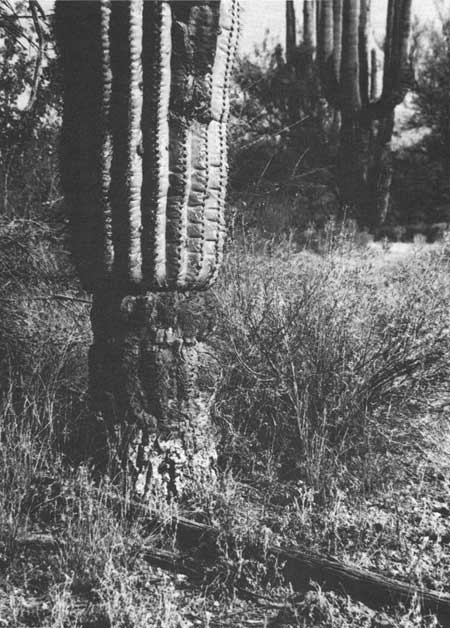
|
| Fig. 54B. Constriction near the base of the stem of saguaros provide a record of previous catastrophic freezes that endures throughout the life of a plant. In some habitats at Saguaro National Monument, the presence of such scars on nearly every saguaro indicates that catastrophic freezes have been a normal part of the local climatic environment for more than 150 years. Photographed 26 June 1973. |
The lack of rotting saguaros noted by Hubbard (1899) reflects the occurrence of mild winters with relatively little freeze-kill of saguaros toward the end of the 19th century. However, low temperature readings in Tucson recorded during the first decade of this century were followed by MacDougal's (1908b) observations of rotting saguaros, and by Shreve's (1910) observation on the ". . . abundance of fallen skeletons. . . ."
The most noteworthy record of low temperature, however, is the 6°F (-14.4°C) Tucson temperature recorded on 13 January 1913. As the first report on catastrophic freeze-kill of saguaros, Thornber's (1916) observations on the devastating effects of that freeze are particularly significant:
. . . during the very cold winter of 1912-13 thousands of small giant cactus plants growing near their greatest altitudinal limits were killed outright. Many other species also suffered great damage.
The Shantz photographs suggest that for a period from the mid-1920s to 1937, there was little or no freeze-caused death of saguaros in the populations at the Saguaro National Monument (east) location. There are no rotting plants, and few skeletons of dead saguaros in any of those photographs (see Fig. 3A).
The catastrophic freeze that occurred in January 1937, and resulting severe damage to warm-desert plants, was the subject of a comprehensive report by Turnage and Hinckley (1938). Although damage to saguaros was not noted in that report, damage to all other species of columnar cacti native to the Sonoran Desert was reported.
Wiggins (1937) reported severe injury to organpipe cacti at Organ Pipe Cactus National Monument and noted evidence of similar injuries sustained during prior freezes. Additional reports of freeze-caused damage to plants are contained in the compiled reports of the National Park Service for that period (USDI 1937).
Although there is no record of damage to or death of saguaros immediately following the January 1937 freeze, subsequent events leave no doubt that it was among the species most severely damaged by that freeze. The spectacular die-off of saguaros first noted in 1939 and continuing into the 1940s (Gill and Lightle 1942, 1946; Mielke 1944; Gill 1951) was the delayed response to the subfreezing temperatures of January 1937, the coldest period in 24 years (Turnage and Hinckley 1938).
It is well known that not all parts of a plant die at the same moment. This time scale of organ death is greatly exaggerated in the saguaro giant cactus. As many as 9 years may elapse between lethal injury and collapse of a freeze-damaged saguaro (Figs. 4B, 14B, and 55A). Thus, the death of large saguaros lethally injured in 1937 escaped recognition until 1939 and later when, with their decay and collapse, death became obvious.

|
| Fig. 55A. Recent and historic evidence of a saguaro population in trouble. The sparsity of small and intermediate-sized saguaros in this population at Saguaro National Monument (east) is a record of response to past environments. The missing size-classes have been eliminated by past events, namely, catastrophic freezes. The foreground saguaro, bearing its last crop of fruits—despite the death of the lower stem—near final collapse as a result of lethal freeze-caused injuries received 7 years earlier in 1962. Photographed 30 June 1969. |
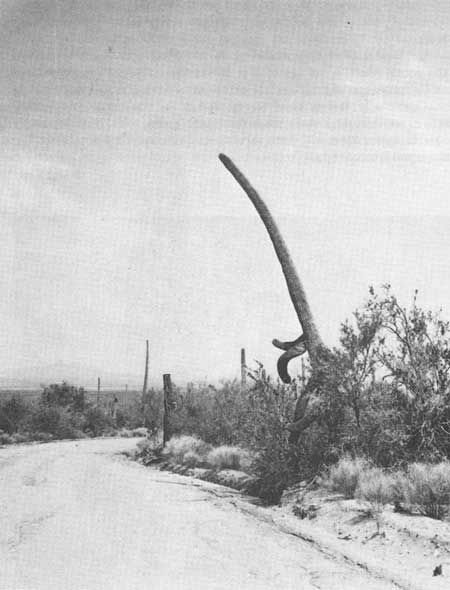
|
|
Fig. 50B. Road-associated 1971
freeze-caused deaths, Saguaro National Monument (west). Vulnerability of
saguaros to freeze-caused death is incresed by proximity to unpaved
roads. The greatest extremes of low temperatures are associated with
high rates of nocturnal re-radiation from large areas of barren
earth. Drooping arms on dying saguaro in foreground are the result of long pre-existing freezing injury. Photographed 9 August 1971. |
Saguaro die-off in response to catastrophic freeze followed by rapid thawing conditions in 1962, reported by Niering et al. (1963) and Lowe (1964), was followed by rapid collapse of many of the stricken individuals (see de Candolle 1852). However, as in the case of the 1937 freeze, the death of many plants did not become evident for one or more years after the freeze. The 1962 freeze also damaged plants at Organ Pipe Cactus National Monument where we observed resulting severe injury to senita and organpipe cacti as well as to other cacti, elephant trees (Bursera microphylla), and other subtropical shrubs.
The initial response of saguaro populations to the freeze of January 1971 is described by Steenbergh and Lowe (1976) and the resulting collapse of saguaros has continued into 1974. We also observed, as a result of the 1971 freeze, damage to organpipe and senita cacti at Organ Pipe Cactus National Monument and, near Tucson, the death of other species of cacti, namely, bisnaga (Ferocactus wislizeni) and the chain-fruit cholla (Opuntia fulgida) (Figs. 56-58). In the Tucson vicinity, we observed severe damage to desert ironwood and foothill paloverde that in some localities resulted in the subsequent death of numerous individuals of both species (Fig. 58B).
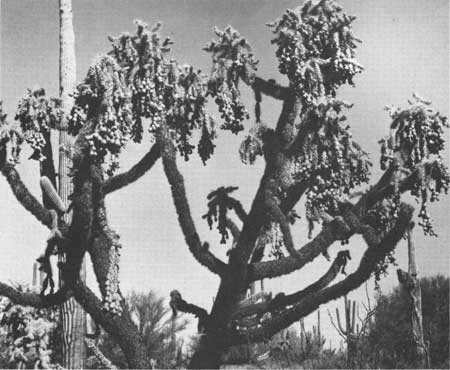
|
| Fig. 56A. Jumping cholla (chain-fruit cholla, Opuntia fulgida) photographed immediately following critical subfreezing temperatures in January 1971. At that time, characteristic symptoms of freeze damage—discolored, watery appearance of softened fruits, and the drooping terminal joints—were widely evident. Within 3 months after the freeze, all but a few withered joints had dropped to the ground. Compare with Fig. 56B. Photographed 19 January 1974. |
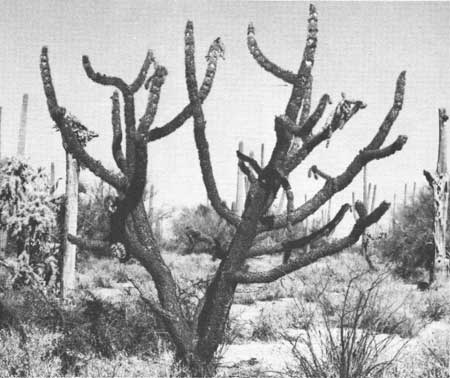
|
| Fig. 56B. Rephotograph of the cholla shown in Fig. 56A. taken approximately 3 years after lethal freeze-caused injury. The plant is dead. Photographed 29 November 1973. |
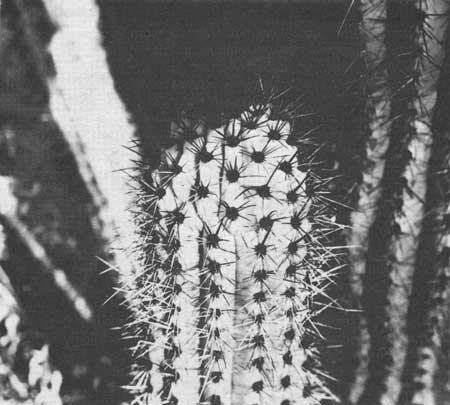
|
| Fig. 57A. Freeze-caused injury in 1971 to organpipe cactus (Cereus thurberi) at Organ Pipe Cactus National Monument. Pale yellow coloration is evidence of severe injury at the stem tip. Resulting constrictions that produce "jointed" stems appear on nearly every organpipe cactus in this northern portion of its range. Investigations of organpipe deaths within the Organ Pipe Cactus National Monument reveal that the damage produced by the 1971 freeze was lethal to a substantial number of individuals in that population. Similar injuries and the subsequent death of organpipe cacti (and other cold sensitive species) were observed following the catastrophic freeze in January 1962. Photographed 3 February 1971. |
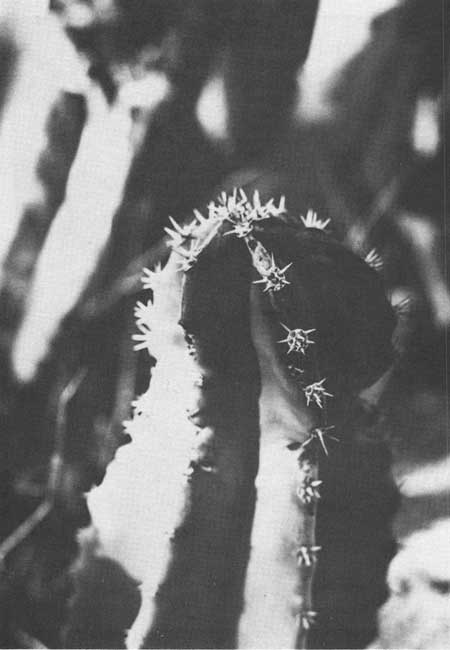
|
| Fig. 57B. Freeze-caused injury in 1971 to senita cactus (Cereus schotti) at Organ Pipe Cactus National Monument. Constriction below the blackened, recently frozen tip is the result of a previously occurring freeze. Similar injuries to stem tips were observed immediately following the severe freeze in January 1962. Photographed 3 February 1971. |

|
| Fig. 58A. Freeze-killed cactus (Ferocactus wislizeni) in 1971 at Saguaro National Monument (east). Numerous other individuals of this species, not killed, received some damage to tissues on the upper portion of the plants. All species of barrel cactus are frost-sensitive. The catastrophic freeze of January 1962 killed more barrel cactus than saguaros on some sites at the upper edge of the desert (1070-1240 m; 3500-4000 ft elevation) on the Santa Catalina and Rincon mountains bordering Tucson on the north and east, respecively. |
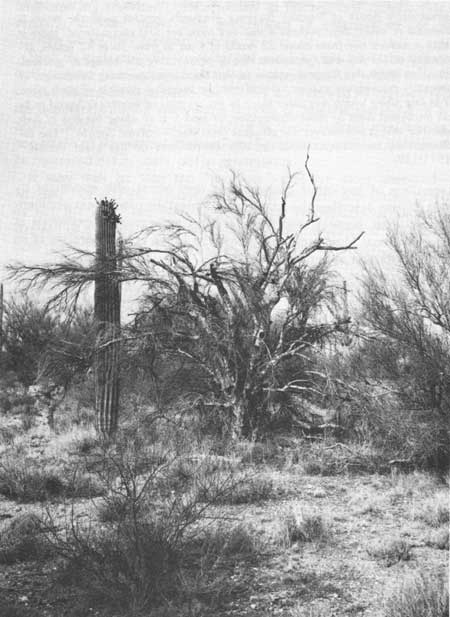
|
| Fig. 58B. Freeze-killed foothill paloverde (Cercidium microphyllum) in 1971 at Saguaro National Monument (east). In addition to freeze-caused deaths, extensive die-back of the foothill paloverde occurred in many localities in southern Arizona and adajacent Sonora, Mexico, following the severe January freeze of 1962 and 1971. In the Tucson Mountains, similar die-back and complete kill of the desert ironwood (Olneya tesota) was evident within a few weeks following the freezes. Photographed 25 June 1974. |
From our observations, it is clear that the population fluctuations of chain-fruit cholla populations long observed by many ecologists (see Tschirley and Wagle 1964) and similar population fluctuations of other cactus species are attributable to freezing. Similarly, it is probable that several of the vegetation changes noted in Hastings and Turner (1965) are attributable to catastrophic freezing.
| <<< Previous | <<< Contents >>> | Next >>> |
chap6c.htm
Last Updated: 21-Oct-2005